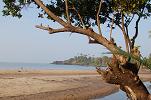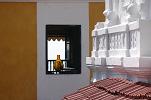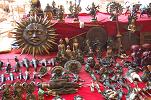|
Goa And Its Portuguese Colonial Period
Portuguese Arrival in the History of Goa With the European powers seeking influence abroad in the 15th Century, the Portuguese set their sights on the ports of the Indian Ocean. The Portuguese knew that crossing the Indian Ocean via the Cape Of Good Hope in southern Africa would open up a route to the spice islands of the Phillipines, and provide easier access to the luxury goods of India. In 1498, Vasco Da Gama set sail to Calicut on the south Indian coast from Lisbon. His arrival there signalled the beginning of the colonial period in the history of Goa. Da Gama's expeditions were marked by atrocities and bloodshed, and thus the Europeans were disliked by the major powers of the region. The sinking of a small Portuguese fleet between Mumbai and modern Goa by the Ottomon Turks and a fleet of Calicut vessels sparked a far greater naval conflict which took place at the Indus Delta and was known as the Battle of Diu. The Portuguese and Muslim fleets involved knew that success here would mean dominance over the Indian Ocean. The Portuguese with better ships and more firepower won outright, and marked the occasion by firing the limbs of their prisoners at towns and villages along the coast. Eleven years after Da Gama arrived in India, and after the Battle of Diu had ensured Portuguese dominance of the Indian Ocean, a permanent enclave was needed on the Indian coast to administer the trade. After bloody battles the Portuguese finally captured the capital of Ela, and set about fortifying the city. It would remain under Portuguese rule for 450 years.
Goa's Decline Several factors contributed to Goa's decline as a Portuguese territory throughout the 17th Century. A recession in Portugal (blamed on labour shortages due to high migration), the spread of diseases such as malaria and typhoid in the colony and the poor position of Old Goa on a river that was beginning to fill with silt all led to the decay and decline of this once rich and prosperous city. Muslim attacks weakened the Portuguese's resistance, and Dutch success on aquiring parts of the Malabar coastal region (south of Goa) meant that the trade routes on which Old Goa grew rich were being commandeered by other powers. The Maratha Wars of 1664 to 1739 further destabilised the Portuguese stronghold in India. Forced to decide between the warring Hindu Marathas and Muslim Mughal armies, the Portuguese incurred the anger of the Marathas by granting safe passage to the Mughals through Goa. This eventually led to the seizing of Margao by the Marathas and the introduction of a treaty which required Portugal to pay compensation in exchange for the withdrawal of Marathi troops from Goa. Losses of territory to other European powers further escalated the financial strains.
Irrespective of the success of the new capital of Panjim, disillusionment was growing among the Portuguese in Goa and at home, and among people native to Goa and its surrounding areas. The path to Goa's independence would be a long one, but by the 1830's events pointed to the fact that it was already underway... Read more about the history of Goa and its road to independence or discover the history of pre-colonnial Goa. Read more about Goa, India. Click here to leave History Of Goa and return to Travel India Goa Guide Home Goa Map -
Goa Festivals -
Goa India Guide -
Weather In Goa -
Indian Religion -
Kerala History
|
|
'Not to be missed' destinations of GoaAn intimate bay where dolphins are commonly sighted, Patnem is one of south Goa's best beach destinations. Spectacular views from Terekhol Fort reward travellers to Goa's far north. Review your favourite Goa restaurant and we will publish it on our site! Find all manner of treasures at the Flea Market that sprawls weekly on a Wednesday across the fields behind Anjuna beach.
|







